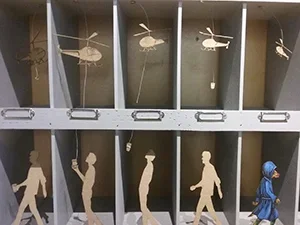Animation Installation
Minuscule fish, dogs, sunrises, and more have taken over unoccupied mailbox spaces in the Barn’s administrative office.

This installation is the work of Visual Arts faculty member Sue Rees’s fall term “2D-3D-2D - Animation in a Created World” class.
Utilizing Adobe After Effects, students explore animation by manipulating 2D objects and making them appear to be in 3D spaces within the program. Then, the course reverses itself: students create objects with laser cutters, staging sequences in the real world. These 3D sequence are then filmed and reexamined in the digital program, where green screen areas were keyed out to substitute digital backdrops to create a final animation.
“I always do an After Effects class because it’s a really solid animation program that’s good for students to use,” Rees said. “But we tend to end up going from a drawn analog world into a digital world, so with this class, we wanted to go back out, make a set, and film that to bring in more digital images and animations.”
Technical Instructor in 3D Technology Michael Stradley and Video Animation Technician Katie Soule also assisted the class with setting up a green screen area and developing stop motion animations.
“There’s something really nice about going from something that’s very physically tactile into a realm that’s more digital,” Rees said.
The process of working alternately in 2D and 3D, Rees said, also interests students who learn in different ways.
“Some people are much happier spending their life in the computer world, and other people want a bit more tactility, so this class appeals to both senses,” Rees said.
Students in the course come away with an in-depth understanding of how to create the illusion of 3D space, whether in After Effects or in the mailbox installations. Though After Effects is a 2D program, the effect of depth can be achieved by layering objects or playing with perspective. In the 3D world, the same effect occurs when placing objects within the mailboxes and tinkering with depth, lighting, and height.
“Some of the students didn’t quite realize what shadows from the hallway lights would do,” Rees said. “You think more of what’s going on as a sequence, but the shadows have an effect, which is sometimes very nice.”
Ten mailbox installation pieces from the course, which were loosely based upon Italo Calvino's Invisible Cities, are currently on display in the mailboxes outside of the Barn’s business office. The installation features the work of India Abbott '19, Maegan George '19, Minahil Ghafoor '18, Eloise Gibbin '20, Paing Hein '20, Lea Lee '21, Amelia Miller '20, Jia Murtaza '18, Hunter O'Brian '19, and Emily Walker '19.
By Natalie Redmond, Associate Writer